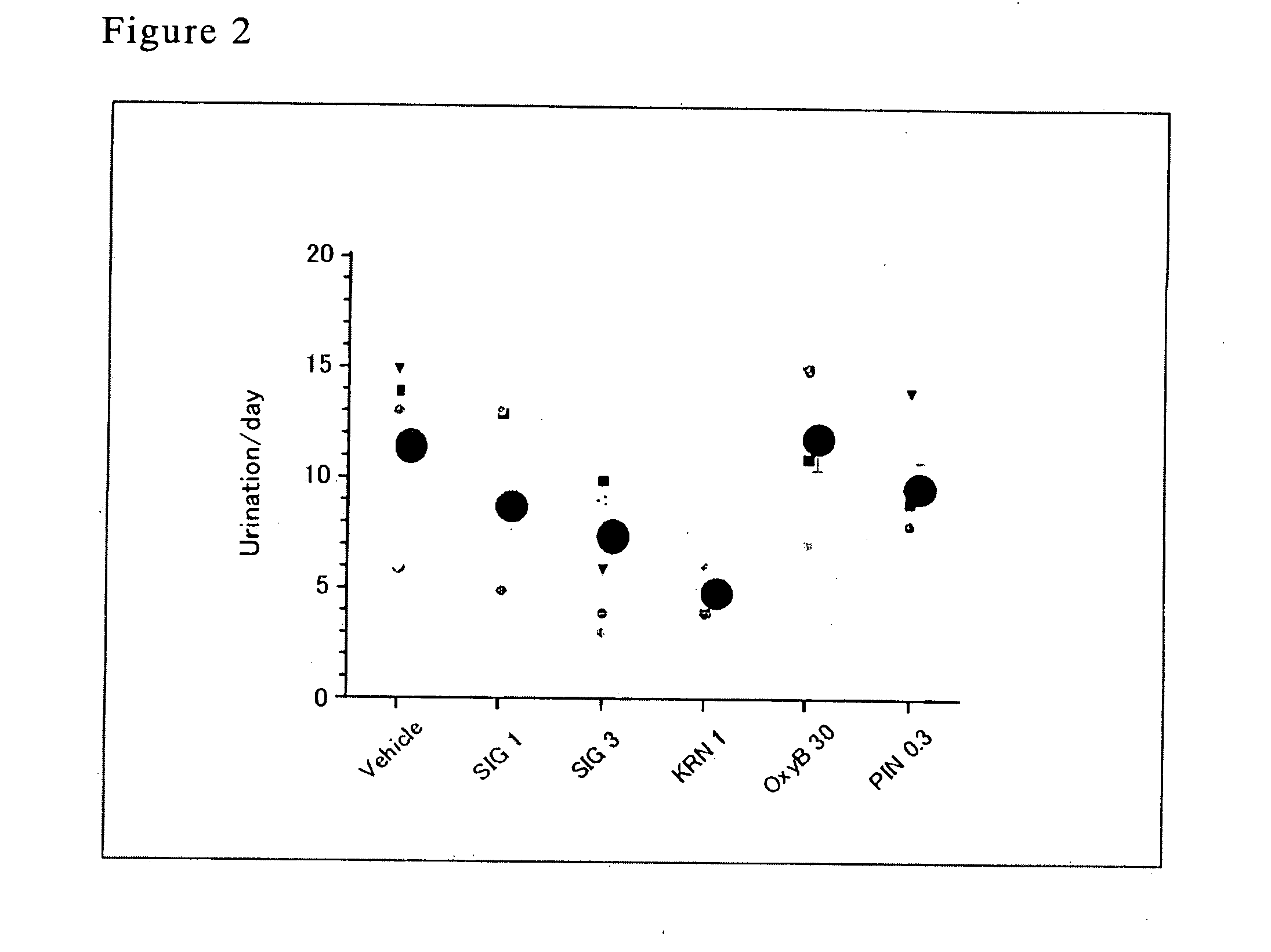Therapeutic Agents For Overactive Bladder
a technology for bladder and overactive bladder, applied in the direction of biocide, cardiovascular disorder, drug composition, etc., can solve the problem that krn2391 cannot be used as a drug in clinical cases
- Summary
- Abstract
- Description
- Claims
- Application Information
AI Technical Summary
Benefits of technology
Problems solved by technology
Method used
Image
Examples
example 1
Disease Model
[0074] There has been established no animal models of disease reflecting frequent urination in elderly male subjects. In carefully searching various kinds of information, nNOS-Knockout mice were pointed out to have a possibility as a model of frequent urination (dilatation of urinary bladder, hyperplasia of smooth muscle, lack of relaxation responses, see Non-patent Document 9 for its creation) in May, 1997 (Non-patent Document 10), but have not been studied as a therapeutic model. nNOS-Knockout mice have now been investigated for their possibility as a model of frequent urination by using an instrument (an observation system for urination behavior, Muromachi Kikai Co., Ltd., Japan) to determine urination dynamics (urination volume and urination frequency) of the mice.
[0075] As a result, dilatation of urinary bladder and hyperplasia of detrusor smooth muscle were observed in nNOS-Knockout mice (8-13 months of age, 30 g body weight, n=9). As compared to normal animals ...
example 2
Pharmacological Effects
[0079] The causes believed to induce frequent urination are hyperplasia or intensive contraction of urinary bladder smooth muscle, as well as disturbance of neurotransmission to urinary bladder smooth muscle. Since nicorandil has both a KATP channel opening action and a nitrate-like action, as shown above, attention was focused on its direct relaxing effect on urinary bladder smooth muscle (mainly KATP channel opening action) and its ameliorating effect on neurotransmission disturbance (mainly nitrate-like action). In this example, an investigation was started with the assumption that nicorandil would have a higher ameliorating effect on frequent urination than commonly used KATP channel openers.
[0080] Nicorandil was given to nNOS-Knockout mice (8-13 months of age) by forced oral administration at 6 mg / kg / day for 7 days using a sound for oral administration. The results obtained are shown in FIG. 1. The urination frequency was significantly reduced from 5.22...
example 3
Comparison of Pharmacological Effects
[0081] KRN2391 is a vasodilator that is developed from and structurally similar to nicorandil used as a lead compound (Non-patent Documents 7, 11, 12 and 13). On the other hand, the effect of KRN2391 on urinary organs has also been reported (Non-patent Documents 8, 14, 15 and 16). When KRN2391 was used as a control drug to compare the effect on daily urination frequency in nNOS-Knockout mice, nicorandil (3 mg / kg) and KRN2391 (1 mg / kg) were found to show a significant ameliorating effect on urination (p<0.05, FIG. 2).
[0082] The daily urination frequency was measured with an observation system for urination behavior (Muromachi Kikai Co., Ltd., Japan).
[0083] Further, oxybutynin hydrochloride (SIGMA), which was a conventional anticholinergic drug, was also used for comparison of the urination frequency (FIG. 2).
[0084] Furthermore, with the aim of clarifying the contribution of the nicorandil's nitrate-like action, pinacidil (SIGMA) known as a pur...
PUM
| Property | Measurement | Unit |
|---|---|---|
| Therapeutic | aaaaa | aaaaa |
Abstract
Description
Claims
Application Information
 Login to View More
Login to View More - R&D
- Intellectual Property
- Life Sciences
- Materials
- Tech Scout
- Unparalleled Data Quality
- Higher Quality Content
- 60% Fewer Hallucinations
Browse by: Latest US Patents, China's latest patents, Technical Efficacy Thesaurus, Application Domain, Technology Topic, Popular Technical Reports.
© 2025 PatSnap. All rights reserved.Legal|Privacy policy|Modern Slavery Act Transparency Statement|Sitemap|About US| Contact US: help@patsnap.com



